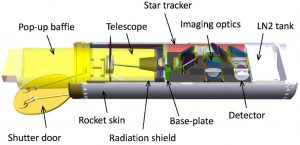The Cosmic Infrared Background Experiment-2:

The Cosmic Infrared Background Experiment-2 (CIBER-2) was launched by NASA on June 6, 2021 from the White Sands Missile Range in New Mexico, USA.
- The aim of this mission is to count the number of stars that exist in the Universe.
- The experiment is measuring a mysterious glow of infrared light that fills our skies called the cosmic infrared background, which is emitted by some of the most common stars.
- While this is not the first time that such a mission has been undertaken, the CIBER-2 instrument has been improved upon to see if any stars had been undercounted in the previous counting attempts.
- The European Space Agency (ESA) infrared space observatory Herschel also counted the number of galaxies in infrared and measured their luminosity previously.
- Scientists have estimated that on average each galaxy consists of about 100 million stars, but this figure is not exact.
- The figure of 100 million could easily be an underestimation, probably by a factor of 10 or more.
- To put this into perspective, an average of 100 million stars in each galaxy (there an estimated 2 trillion of them as per NASA), would give a total figure of one hundred quintillion stars or 1 with 21 zeroes after it.




